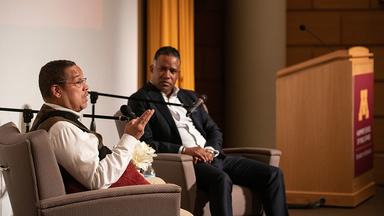Angie Fertig, social policy research scientist at the Humphrey School of Public Affairs, is part of a new University of Minnesota research project to examine how structural racism and discrimination (SRD) experienced at the individual, neighborhood, institutional, and societal/policy levels affect whole person health across the life course. This includes mental, physical, behavioral, and social health.
The project, funded by a $3.3 million grant from the National Institutes of Health, is led by Jerica Berge of the Medical School and also includes investigators from Pediatrics, the School of Public Health, the Minnesota Population Center, and the University of Georgia. The findings will be used to recommend interventions that will promote health equity.
We asked Fertig to explain the importance of this research and how it will be conducted.
What is structural racism and discrimination (SRD), and how can it affect people's health?
Structural racism exists in systems set up to limit opportunities and resources to individuals and communities of color.
A powerful example of structural racism is redlining, which cut off the wealth-building opportunity of home ownership for people of color, and is still strongly associated today with racial homeownership and wealth gaps, and where people of color live in the Twin Cities and across the country.
Structural racism is everywhere—in your school, workplace, health care clinic, in your neighborhood in terms of safety and green space, while you are driving, in our criminal justice system, and in how safety net policies, immigration policies, and voting policies are set up.
To be swimming in structural racism every day as a person of color can cause chronic stress, can lead you to not trust your doctor, can destroy your sense of community, and can even erode your belief in your own value. All of these things are terrible for your physical and mental health.
What does 'life course' mean?
Life course means looking at people at different stages of their lives. In this study we're looking at children as they become adolescents, and we're looking at their parents and grandparents, if they live in multigenerational households, who are at different stages in their lives.
How will the study be conducted?
We will be studying outcomes from a racially/ethnically diverse sample of children and parents from the Twin Cities in Minnesota and a rural area near Athens, Georgia. The team is made up of researchers at the University of Minnesota and the University of Georgia, which explains the location selection.
We argue that the types of structural racism and discrimination that families are exposed to may be different in these two locations, so that will give us some variation to see what kinds of structural racism are particularly related to different health outcomes. The funding allows us to follow a fairly large sample of families for two years (600 families in the Twin Cities and 300 from Athens).
Right now we are collecting structural racism measures and preparing to launch recruitment of participants. I have hired a student researcher to help me collect measures of structural racism across the entire U.S. At the same time, some members of our research team are getting the survey instruments ready to go, and others are working on relationships with community organizations who will help us recruit participants from several racial/ethnic groups. It is a huge team effort.
What types of data will you be collecting?
We plan to collect and analyze a lot of quantitative data on structural racism and discrimination and see how it’s related to a variety of health outcomes. We're hoping to collect SRD measures at many levels: individual (e.g., perceptions of discrimination), neighborhood (e.g., safety), institutional (e.g., school disciplinary practices), and societal/policy (e.g., welfare policies, voting policies). In terms of health outcomes, we will be collecting data on health measures like cortisol (a stress hormone), weight, blood pressure, and depression.
What is unique about this approach?
Most studies of structural racism have focused on one or two measures at a time, while we are planning to collect a large variety of measures. We are also going to collect biomarkers (from blood and hair samples), which will allow us to detect health issues in more detail than from self reports.
How do you hope to use this information?
The findings from this study will add to our understanding of the relationship between structural racism and various health disparities at all stages of life. Policymakers, health care providers, and communities can then use that information to develop appropriate remedies that will lead to better and more equitable health outcomes.



